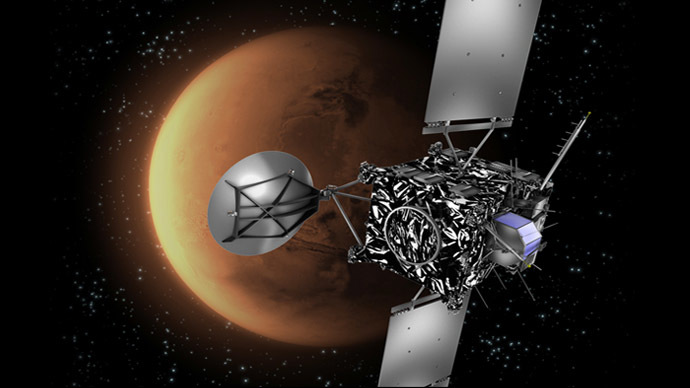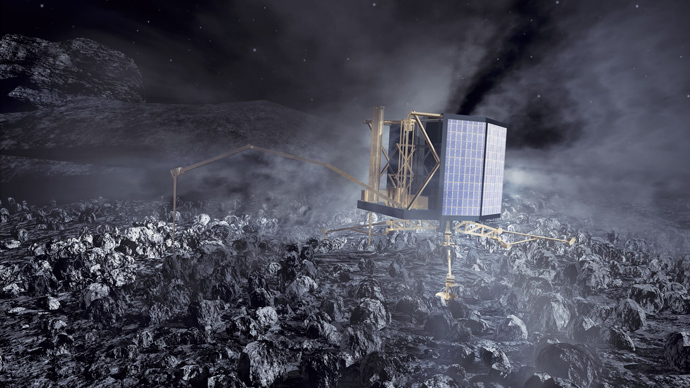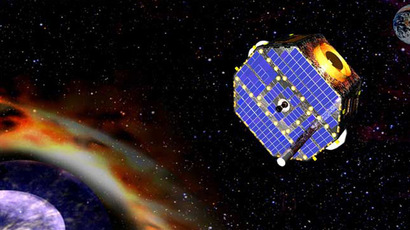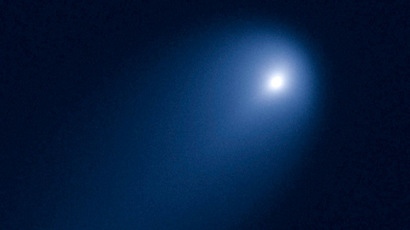Robot spaceship wakes up to harpoon comet in 'Moby-Dick' style hunt through space

A 10-year space hunt is set to reach its climax as the spaceship Rosetta has been woken up Monday from a two and a half year slumber to harpoon a passing comet. The European Space Agency has caught the signal coming from 807,000,000 km from Earth.
The encounter, between the European Space Agency’s robot craft and the Churyumov-Gerasimenko comet, could yield vital clues about the beginning of our solar system and the origin of life on Earth through analysis of the comet’s composition.
At 17:30 GMT Monday, the Rosetta spacecraft was reactivated from hibernation mode. Some 45 minutes later, a signal was registered by the Canberra control center in Australia and NASA's Goldstone center in California.
RT @ESA_Rosetta: “Hello, world!"
— ESA Operations (@esaoperations) January 20, 2014
The spacecraft had been “sleeping” because its course had taken it too far away from the Sun to use its solar panels.
Now the Rosetta will track the comet in the Sun’s orbit. After monitoring the comet’s surface, it will hook the comet with harpoons and travel with it for a year – to learn its secrets and send them back to Earth.
FIRST TELECOMMAND SENT: ESA's @ESA_Rosetta team has sent the 1st commands in >31 months to #Rosetta
— ESA Operations (@esaoperations) January 20, 2014
The rendezvous is expected to last from August 2014 to November or December 2015.
The space hunt, reminiscent of the great whale hunt in Herman Melville’s classic novel Moby-Dick, reflects an obsession not by a crazy revenge-fueled Captain Ahab, but by scientists to learn the comet’s secrets, will be crowned by the launch of two harpoons into the frozen gaseous comet, named Churyumov-Gerasimenko for the two Soviet scientists who discovered it in 1969.
Message from 800 million km away
The European Space Agency’s spacecraft, launched back in 2004, will take up to six hours to warm up before it can find Earth using star trackers and send a wake-up confirmation signal.
With one-way signal time of 45mins, it will take at least 90mins to get health report from @ESA_Rosetta - for now basic radio signal only
— ESA Operations (@esaoperations) January 20, 2014
It is expected for the signal to take another 45 minutes to reach mission control at Darmstadt, Germany. The probe is currently flying some 807 million kilometers from Earth (and some 673 million kilometers from the Sun).
NASA’s deep space tracking dishes in Goldstone, California (each 70 meters in diameter) and the Canberra station in eastern Australia, as well as European Space Agency’s New Norcia 35-meter antenna in Western Australia will be awaiting the signal.

Rosetta was designed to perform a detailed study of comet 67P/Churyumov–Gerasimenko by both orbiting the space body and landing a 100-kilogram Philae probe on the comet’s surface. The probe will fix itself to the icy surface of the comet with two harpoons aboard.
Unlocking the comet’s frozen data
So far scientists have never been able to research nucleus of a comet directly. That’s why it is so important that Philae analyze chemical composition of the comet ice.
European scientists are particularly interested in finding out whether there will be any traces of organic amino acids.
According to the panspermy theory, the material that began life on Earth could have been brought from outer space within the ice that makes up comets. Because comets are essentially huge freezers, they could keep invaluable information about the beginning of our solar system.
Rosetta is anticipated to approach the comet in August 2014 to spend a couple of months studying and mapping the icy body, measuring approximately 5 kilometers by 3 kilometers, before dropping a probe on its surface to gather samples and take pictures.

Operated by solar energy, Rosetta spacecraft has two huge 14-meter long solar panels that will bring energy to the equipment aboard. The spacecraft was induced into a deep sleep in mid-2011 to conserve energy as it flew far away from Sun’s rays towards the orbit of Jupiter.
“It flew almost 10 years in space and in the last
two-and-a-half years it was so far from the Sun that we couldn't
keep it completely active so we had to switch it off,” said
Dr. Paolo Ferri, Head of ESA's Mission Operations Department.
Rosetta has been out of contact with mankind for 31 months (957
days). The overall distance covered by the spacecraft is
estimated at 7.1 billion kilometers.
In the last decade, the spacecraft has already performed some successful asteroid flyby missions on its way to the comet. The craft completed its fly-by of asteroid 2867 Steins in September 2008 and of 21 Lutetia in July 2010. In 2007, Rosetta also performed a Mars flyby and has sent images back to Earth.
Defending the Earth from crashing comets
Space scientists believe that comets remain practically intact from the very formation of our solar system some 4.6 billion years ago and there are millions of them in the Solar system.
“Over the millennia of the history of earth comets have actually affected our evolution, they probably have affected the evolution of life as well, from the start of life to the destruction of life,” Ferri said, explaining why comets played such an important role in our planet’s history.
At 21:34CET, ESA's 35m deep-space antenna at #NewNorcia, Australia, will start tracking #Rosetta. Here's how it looks http://t.co/rCqMoIqAdx
— ESA Operations (@esaoperations) January 20, 2014
“There are many theories about comets hitting the earth and causing global catastrophes. So understanding comets is also important to see in the future what could be done to defend the earth from comets,” Ferri said.
Periodic comet 67P/Churyumov-Gerasimenko was discovered in 1969 by Soviet astronomers Klim Churyumov (now the director of a planetarium in Kiev, Ukraine) and Svetlana Gerasimenko (currently living in Tajikistan). Both scientists were invited to Kourou cosmodrome in French Guiana in 2004 to witness the beginning of Rosetta mission launched into space by Ariane 5G+ booster.
Churyumov-Gerasimenko belongs to the Jupiter family of comets. It rotates every 12.7 hours and has an orbital period of 6.55 years.














